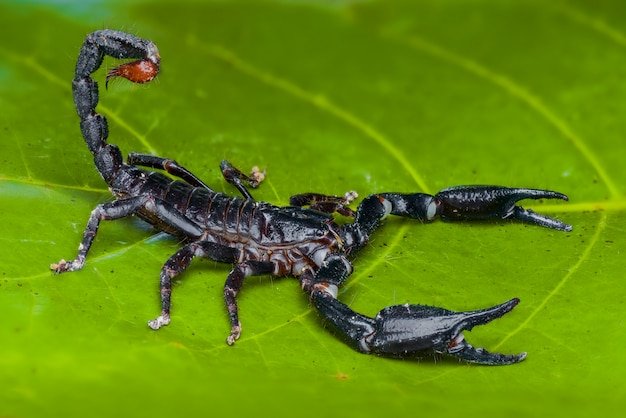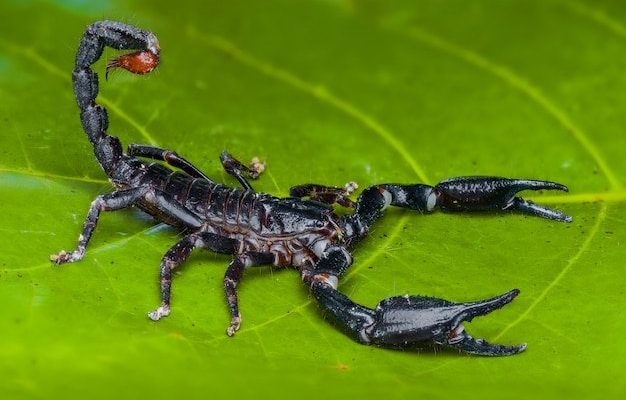
These fascinating arachnids, belonging to the family Scorpionidae, can be found in the lush jungles of Southeast Asia. They thrive in humid climates, often hiding under rocks or in tree hollows. While they might seem like mere predators, they have a deeper role in the complex web of life. Understanding their significance not only gives us insight into their natural behaviors but also highlights how they contribute to the broader ecosystem. So grab your favorite coffee, and let’s dive into the intriguing world of the Asian Forest Scorpion!
Understanding The Asian Forest Scorpion
The Asian Forest Scorpion (Heterometrus spp.) is characterized by its large size, reaching up to 8 inches long. Their bodies are typically black or dark brown, giving them a sleek, menacing appearance. They have a distinctive pair of large pincers and a stinger, which they use for hunting. But don’t worry; while their sting can be painful, it’s rarely life-threatening to humans.
You might be wondering how these creatures fit into their environment. Unlike many larger predators, Asian Forest Scorpions are more like the night watchmen of their habitat. They primarily feed on insects, helping to keep pest populations in check. This makes them crucial players in controlling the ecological balance of their surroundings, much like a good health regimen keeps our bodies in order.
The Role of Scorpions in Pest Control
Asian Forest Scorpions are voracious eaters, preying on insects like crickets, cockroaches, and even other smaller arachnids. Think of them as nature’s pest control service. By keeping the population of these insects in check, they prevent overpopulation that can lead to significant damage to various plants and crops.
In many ways, this pest control helps maintain a healthy environment. Without these scorpions, we could see a rise in harmful insects that could disrupt the food chain, affecting not just plants but also the animals that rely on them for sustenance. So, the next time you spot one of these scorpions, remember they’re doing their part to help strike a balance in nature.
Scorpions as Prey: A Vital Link in the Food Chain
Not only are Asian Forest Scorpions predators, but they themselves are also prey for larger animals, such as birds, snakes, and other mammals. This relationship adds another layer to their role in the ecosystem. By serving as a food source for these predators, scorpions help transfer energy through the food chain.
Imagine a vibrant forest where every creature plays an important part. The scorpion’s existence supports various other species, ensuring they have the nutrients they need to thrive. It’s a perfect example of how interconnected nature truly is. If scorpions were to disappear, it could lead to an imbalance, eventually impacting wildlife diversity in their habitat.
Scorpions and Soil Health
Another often overlooked aspect of the Asian Forest Scorpion’s role in ecosystems is its contribution to soil health. As these scorpions hunt and feed, they help aerate the soil through their burrowing activities. This aeration allows for better water infiltration and helps promote healthy root growth for plants.
Moreover, the waste produced by the scorpions serves as organic fertilizer, enriching the soil. This creates a thriving environment for plants, which, in turn, provides food and shelter for countless other creatures. So, when you think about soil health, remember that even the tiniest organisms contribute to our planet’s overall ecosystem.
The Asian Forest Scorpion: A Unique Adaptation
Asian Forest Scorpions have adapted remarkably to their environment. They’re nocturnal, meaning they’re active at night and prefer to stay hidden during the day. This behavior not only protects them from predators but also helps them conserve moisture in their humid habitats.
Their adaptation extends to their hunting tactics. Scorpions use both speed and stealth to catch their prey, relying on their pincers to immobilize them quickly. This unique method of hunting is a testament to their evolutionary success, allowing them to thrive in the competitive world of the forest. These adaptations underscore how every species has developed unique traits to survive, further enriching biodiversity.
Human Interaction and Conservation
With increasing urbanization and deforestation, the habitats of the Asian Forest Scorpion are rapidly vanishing. Sadly, this threatens their populations and the balance they help maintain. Conservation efforts are crucial to protect these creatures and the intricate ecosystems they support.
Education plays a key role in this conservation. Many people fear scorpions, leading to misconceptions about their nature. Understanding their importance can help shift perspectives, encouraging people to protect rather than eradicate them. So, whether by supporting nature reserves or educating others on the significance of these creatures, every small action counts.
In summary, the Asian Forest Scorpion is far more than just a creepy crawly. It plays an essential role in pest control, serves as prey for larger animals, contributes to soil health, and showcases incredible adaptations for survival. These scorpions are true heroes of the ecosystem, quietly working behind the scenes to maintain balance in the natural world.
As we explore and understand the role of the Asian Forest Scorpion, we gain appreciation for the complexity of life around us. Every creature, no matter how small or seemingly frightening, contributes to the tapestry of life. In protecting these unique arachnids, we’re also helping to preserve the entire web of life they support. After all, nature’s balance relies on each thread, including the often-overlooked scorpion.

